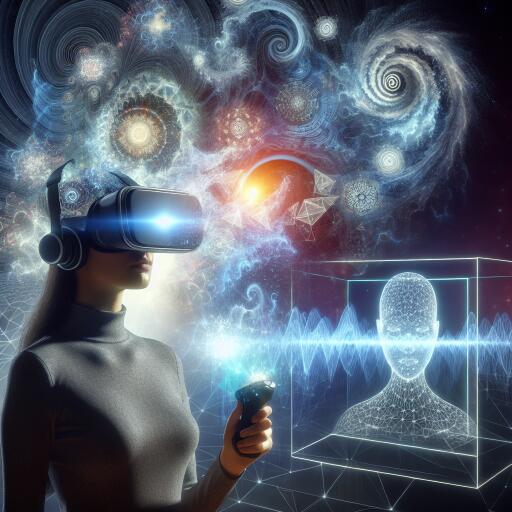“Unlocking Emotion and Identity: Innovations in AI Speech and VR User Recognition”
As technology continues its ceaseless evolution, the synergy between artificial intelligence (AI) and virtual reality (VR) is reshaping our understanding of emotions and identity. Have you ever imagined your devices not just hearing you, but truly feeling you? As AI advances in its emotional comprehension through sophisticated voice analysis, it invites us into immersive realms with interactions molded by our emotional states. Envision a VR scenario where your emotional state personalizes the narrative, creating experiences deeply aligned with your essence. Nevertheless, this innovation also poses challenges: How can these technologies enhance experiences while respecting our identities? This article delves into the groundbreaking strides in AI speech recognition and VR identity detection, unlocking new avenues for emotional engagement and laying a foundation for the future of both personal and digital interaction. Get ready to be stirred by the potential at the confluence of empathy and avant-garde technology!
The introduction of the LUCY system signifies a major leap in AI’s capability to interpret and respond to human emotions. This cutting-edge speech model employs a three-stage data processing pipeline, heightening emotional intelligence in dialogue generation. With a fast decoding rate and specially designed tokens for emotional control, LUCY crafts responses that are not only natural but richly informative. Training on diverse voices, it accurately discerns emotions across languages such as Chinese and English. Performance is further augmented by token delay mechanisms, ensuring improved response quality.
LUCY’s innovations portend significant impacts for conversational agents, empowering them to engage with greater empathy through precise emotional interpretation. This capability enables businesses to offer refined customer interactions driven by sentiment analysis. As AI models evolve alongside multimodal approaches to audio interpretation, their application spans industries from mental health to personalized education, where emotional understanding is pivotal for fruitful communication.
How VR is Transforming User Identity Recognition
In virtual reality, the refinement of user identity recognition is leveraging advanced technologies to heighten user interaction. Integrating movement patterns with behavioral biometrics is key to discerning users within immersive realms. Employing machine learning, researchers achieve impressive accuracy in behavior analysis. This approach not only strengthens security but customizes interactions based on personal preferences.
The efficacy of user identification rests on combining movement data with network traffic insights, enabling more reliable identification processes while addressing privacy issues associated with network monitoring. Implementing a majority voting methodology significantly boosts identification accuracy during VR sessions, mitigating errors from shifting user behaviors or environmental factors.
Forthcoming research will likely explore authentication systems ensuring secure VR access seamlessly. Additionally, inter-session identification techniques could foster session continuity while adhering to security protocols. As technology grows, it is vital to develop robust threat models and protective measures against vulnerabilities in these pioneering applications.
The LUCY system marks a noteworthy advancement in speech technology, centering on emotion control and natural dialogue. By deploying special emotional control tokens, LUCY elevates dialogue expressiveness. The rapid decoding rate facilitates real-time interactions, and diverse voice training ensures adaptability across various speakers. Token delay implementation further enhances response quality by reducing abrupt conversational shifts. Evaluations point to LUCY’s impressive proficiency in emotion recognition across languages, illustrating its versatility. This novel approach positions LUCY as a premier contemporary speech model.
Emotional intelligence is vital for creating engaging conversational agents. The three-phase processing pipeline used by models like LUCY fosters nuanced understanding of context and sentiment. Compared to traditional models, these novel systems show substantial performance improvements in response relevance and user satisfaction. As natural language processing frameworks progress, implications stretch beyond communication; they influence a wide spectrum of applications from service bots to therapeutic chat tools, transforming human-machine interaction with emotionally perceptive technologies.
Emotion recognition technology enriches user experience, facilitating more intuitive, responsive interactions with AI. LUCY exemplifies this development, using a sophisticated model that couples emotion control with natural and informative responses. Through special emotional modulation tokens, it crafts conversations based on emotional states.
The system’s training encompasses diverse voices and a comprehensive three-phase processing pipeline, ensuring accurate emotion recognition across multiple languages. This flexibility allows conversational agents to adapt dynamically, enhancing user interaction satisfaction. Fast decoding minimizes token delay, improving response quality while maintaining emotionally aware dialogue. As these technologies advance, they enable enriched human-computer interactions, where empathy is central—reshaping perceptions of AI in domains from customer service to personal assistance.
The AI and VR union is transforming various sectors, with the LUCY system at its forefront. This speech model sharpens emotional intelligence in dialogue, enabling more natural interactions. Evolving systems promise data processing precision across languages and modalities, enhancing performance. Such advancements transcend practical applications, refining user experience in real-time, from gaming to customer service.
Innovations like RelightVid redefine video editing within virtual realms, maintaining temporal consistency with nuanced illumination control. These advancements not only enrich user experiences but suggest collaborative editing possibilities using high dynamic range (HDR) methodologies. Machine learning’s application to VR user recognition highlights behavioral biometrics’ role, set to advance privacy-respecting authentication precision.
In conclusion, AI and VR are revolutionizing our grasp of human emotion and identity. AI’s interpretive prowess in analyzing speech patterns and emotions is enhancing interaction quality across platforms. VR enriches this by tailoring immersive environments to user identities and emotions. However, as these technologies progress, it is crucial to remain conscious of ethical considerations regarding privacy and consent. Future trends anticipate deeper technological fusion, foreshadowing even more personalized digital engagements. Embracing these innovations, alongside a commitment to ethical integrity, is key to fully leveraging AI-driven emotional and identity technologies in our increasingly interconnected world.









